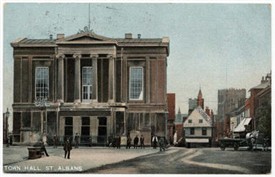St Albans Town Hall

The Town Hall – a brief history
Designed by George Smith and Built in 1830, the Town Hall with its Neo-Classical style presented the inhabitants of St Albans with an edifice totally new to this country town.
The site was arrived at after some discussion between the Corporation and the Justices. The latter had proposed a site in Romeland whilst the Corporation preferred the present position and refused to sell to the Justices the Romeland site. In 1828 an agreement was reached whereby a combined Town Hall and Court House was built on the condition that the freehold remained with the Corporation. This eventually was resolved with one third to the Corporation and two-thirds to the Magistrates, while later in the 19th century, when the County Council was set-up, they took over the building with certain rights being retained by the Corporation.
The building as described in Pevsner’s Buildings of England in a “Giant portico of four fluted Ionic columns, placed on a plinth of full ground floor height with the main entrances between robust Tuscan pillars”. The portico thus appears to stand too high as if it were on stilts. To the east and west are large tripartite windows with straight lintels decorated with wreaths, all in the best Grecian taste! While not retaining the open lower floor of medieval town halls which incorporated market stalls, the building maintains close links to the town’s famous market by virtue of it’s main entrance onto the market square enabling the stalls to reach directly into the building.




